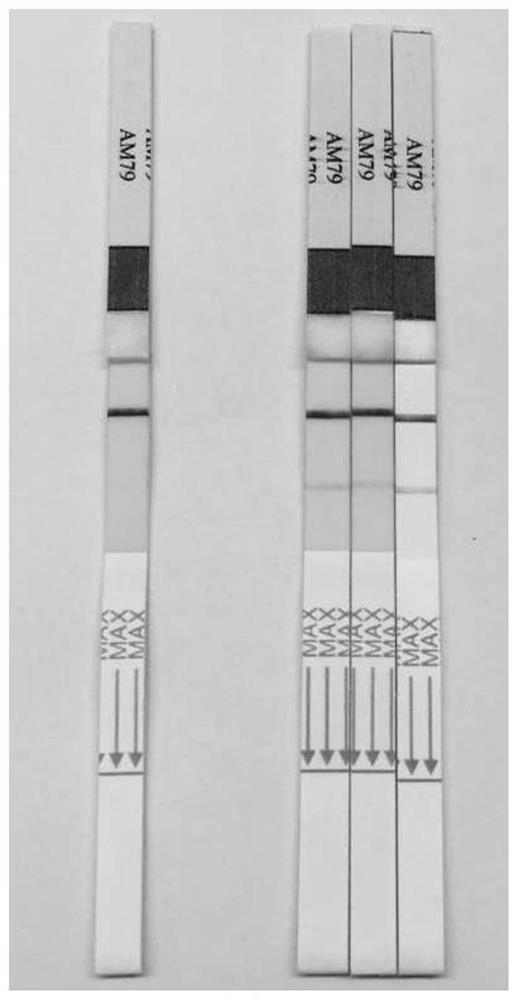Test strip, preparation method and application thereof in transgenic protein AM79 EPSPS detection
A technology of test strips and detection areas, applied in the field of biochemical detection, can solve the problems of complicated operation, high cost, and long time consumption, and achieve the effect of simple operation, good sensitivity, and short detection time
- Summary
- Abstract
- Description
- Claims
- Application Information
AI Technical Summary
Problems solved by technology
Method used
Image
Examples
Embodiment 1
[0042] The making of embodiment 1 transgenic protein AM79 EPSPS immunoassay card
[0043] In each test card, the size of the sample pad is 4mm×15mm, the size of the marker pad is 3mm×4mm, the size of the nitrocellulose membrane is 4mm×28mm, and the size of the absorbent pad is 4mm×19mm.
[0044] Immobilize 40ng colloidal gold-labeled mouse anti-AM79 EPSPS monoclonal antibody on the gold standard pad of each detection card, immobilize 0.8μg mouse anti-AM79 EPSPS monoclonal antibody on the detection area on the nitrocellulose membrane and immobilize 1.0μg anti-AM79 EPSPS monoclonal antibody on the control area. Mouse IgG secondary antibody.
[0045] Paste sample pads, gold standard pads immobilized with colloidal gold-labeled specific monoclonal antibodies, nitrocellulose membranes, and absorbent pads in sequence on the bottom plate. Then it was dried under vacuum at 37 °C for 2 h.
Embodiment 2
[0046] Example 2 Effect Evaluation of Transgenic Protein AM79 EPSPS Immunoassay Card Detecting Protein Standards
[0047] ① Add 200 μL blank sample solution EB004 buffer solution (pH7.4, 0.2mol / LPBS: 8g sodium chloride, 3.35g disodium hydrogen phosphate dodecahydrate, 0.2g potassium dihydrogen phosphate, 0.2g potassium chloride, Dissolve in double-distilled water to 1 L), insert the quick test paper into the sample cup, react at room temperature for 8 minutes, and observe the color development result in the result observation area. The results show that the T line does not show color in the observation area, but the C line shows color.
[0048] ② Add 100 μL of 0.1 μg / ml AM79 EPSPS protein standard 1 (diluted with the same PBS solution as above) to the sample cup, and follow the same operation steps as the blank sample. The results show that the C line (control area) and T line (detection area) in the observation area develop color simultaneously.
[0049] ③ Add 100 μL of 0.1...
Embodiment 3
[0051] Example 3 Effect Evaluation of Transgenic Protein AM79 EPSPS Immunological Detection Card for Detecting Actual Transgenic Soybean Leaf Samples
[0052] 1. Plant leaf tissue extraction method:
[0053] 1. Place the plant leaf tissue between the lid and the body of the disposable tissue extraction tube, quickly cover the lid, and repeat 2 times to obtain 2 circular leaf tissues. Place the leaf blade at the bottom of the extraction tube with a pestle. Mark the tube wall with a marker pen.
[0054] 2. Insert the pestle into the tube, rotate the pestle to crush the leaves, and press continuously for 20-30 seconds.
[0055] 3. Add 0.2 mL (about 8 drops) of extraction buffer EB004.
[0056] 4. Repeat the crushing step to fully contact and mix the sample with the buffer. Remove the pestle (note that the pestle should be used only once to avoid cross-contamination between different samples), and obtain the sample to be tested.
[0057] 2. Sample testing
[0058] 1) Add 200...
PUM
 Login to View More
Login to View More Abstract
Description
Claims
Application Information
 Login to View More
Login to View More - R&D Engineer
- R&D Manager
- IP Professional
- Industry Leading Data Capabilities
- Powerful AI technology
- Patent DNA Extraction
Browse by: Latest US Patents, China's latest patents, Technical Efficacy Thesaurus, Application Domain, Technology Topic, Popular Technical Reports.
© 2024 PatSnap. All rights reserved.Legal|Privacy policy|Modern Slavery Act Transparency Statement|Sitemap|About US| Contact US: help@patsnap.com










